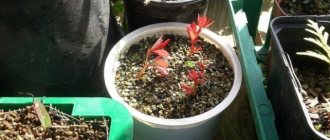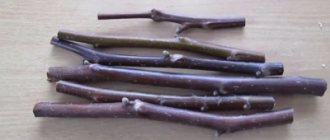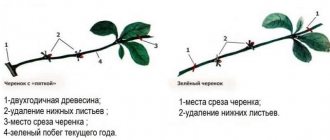Methods for propagating climbing roses
Climbing roses, like many other crops, can be propagated by seeds.
However, gardeners who keep these beautiful flowers most often choose vegetative propagation. This is the most effective and efficient way to increase the number of roses on your site. The basis of this method is the ability of climbing beauties to regenerate their body from one part of themselves - a leaf, stem, root. By the way! All cultivated roses are propagated vegetatively.
Plants obtained by vegetative propagation are called self-rooted, since, once a leaf or shoot is planted, these parts become overgrown with their own roots, from which a new plant can be grown that has the same genes as the mother one.
Roses can be propagated vegetatively in several ways:
- layering;
- root suckers;
- cuttings;
- dividing the bush.
In addition, a new rose bush can be obtained by grafting (grafting) an eye (bud) of a varietal rose onto a healthy wild rose bush. This method is called “budding”. Grafted roses grow faster than self-rooted ones, but caring for them is more labor-intensive. Roses grown on “their own” roots have high vitality - they are more hardy and winter-hardy.
The easiest way for an ordinary gardener to propagate roses is by suckers, layering or cuttings. These are the least labor-intensive and more effective methods. However, it is worth considering that not all varieties of this flower can be propagated by cuttings. But flowering from new plants can be achieved only after a couple of years. Budding technique is a little more complicated than previous propagation methods and requires additional skills from the gardener. In addition, there is a need to obtain healthy, well-developed rootstocks.
Each method has its pros and cons. An analysis of each method in more detail will help you decide which one to use.
Additional Tips
In order for the propagation of climbing roses to be effective and for all young plants to take root, it is recommended to plant them in an area where there is sufficient sun. It is a sunny place and timely watering that will allow you to get a lush, fragrant rose when propagated by any of the listed methods.
By decorating your garden with a climbing rose, you can be sure that the flower corner will attract attention. After all, a rose of any kind will provide an unforgettable experience when you get to know it closely. The smell, beauty, and grace of this flower will create a special mood and add elegance and modernity to the entire garden.
Timing of procedures for propagating climbing roses
Each reproduction method has its own timing. Thus, green cuttings are usually carried out from the end of June to the third decade of July. If you plant cuttings later than July 15, they will not have time to germinate before winter and will die. If the cuttings were prepared in the fall, then they are planted in the ground in March-April, but only in a greenhouse or conservatory. Some gardeners manage to plant cuttings even in September. But with this method, it is important to securely cover the plantings for the winter or move them home until spring.
It is recommended to carry out grafting in spring and summer - this is due to the beginning of sap flow (in roses, intense sap flows twice during the warm season: April-May and July-August). It is customary to carry out budding at such a time due to the fact that during sap flow the bark is easily separated from the cambium, which means that the rootstock will be easier to prepare. In addition, it is at this time that all life processes of the pink plant go faster, and therefore fusion will occur in a short time.
By the way!
Experienced gardeners manage to carry out budding in winter. To obtain a positive result, the scion and rootstock must be prepared in advance: the rootstocks are dug up in the fall and stored in a cold place, and the scions are cut in advance. Tabletop grafting allows you to more accurately connect the scion to the root collar of the rootstock.
Layers for rooting are selected and dug into the ground at the end of March, as soon as the snow has completely melted and the growing season will soon begin. From the cuttings, a new plant is obtained by mid-autumn. At the same time, the offspring are rooted. The division of the bush is carried out in early spring, planting the separated parts of the plant immediately in open ground. By autumn they will have taken root sufficiently to bloom successfully next year.
Features of growing roses at home
Growing roses from cuttings has its advantages:
- longevity of life and flowering period;
- do not regenerate into wild ones;
- adapt well to the environment;
- not picky about soil.
There is also a drawback: overwintering rooted cuttings is difficult. This is due to the fact that during the autumn-summer period a sufficiently powerful rhizome does not grow, so in the first winter the rose is dug up and placed in the cellar (if the temperature in it does not drop below minus 5 degrees Celsius) or is stored in a dry house cool place.
Cuttings
Propagation of roses by cuttings is one of the most popular and simplest methods of propagation; the main thing in this procedure is to prepare them correctly. Select this year's shrubs that have recently finished flowering or are about to bloom. If the spikes are easily removed, this is a sign of their suitability.
Use the middle part of the shoot, remove the thorns and lower leaves.
It is recommended to cut branches in the evening or early in the morning. Cut 15-centimeter lengths with 2-3 nodes (pairs of leaves) and the same number of buds. To do this, use a clean and sharp tool so that the branches are not injured.
The cuts must be made obliquely. Make one immediately below the lowest node, and the other a couple of centimeters higher than the top one. To prevent moisture evaporation, shorten the leaves by a third.
Rooting
To ensure successful rooting of rose cuttings, dip them in any of the root growth stimulants:
- Epin;
- Kornevin;
- Heteroauxin.
You can prepare a stimulating liquid for root growth yourself using the folk method: dissolve honey (1/2 teaspoon) in 200 g of water. The cuttings are kept in the solution from three days to two weeks, since the root system develops depending on the temperature in the room.
Soil preparation
The soil is prepared in the following proportion: two parts of black soil, one each of turf and sand. The dug holes are pre-filled with a 3-5% solution of potassium permanganate.
After planting, it is necessary to mulch with a three-centimeter layer of sand: it is better to use river sand, as it has a large dispersion.
Care after planting in open ground
After planting the cuttings in the ground, they are covered with glass jars to create a greenhouse effect. After two weeks, for the purpose of hardening, the container is temporarily removed, and after some time it is removed completely.
Watering is not carried out too intensively, maintaining light soil moisture and watching for condensation on the walls of the vessel, since oversaturation with moisture can lead to rotting.
If buds form on young shoots during growth, they must be pinched so that the plant’s strength is spent not on flowering, but on the development of the rhizome.
Seed propagation
The most labor-intensive and time-consuming method is that it takes many years to get an adult flowering plant. Most often, seed propagation is used by breeders or amateur rose growers who want to obtain a new unique variety or grow a rootstock for roses. To propagate roses in this way, seeds collected by yourself or purchased in a store are suitable.
Note!
From seeds it is impossible to obtain a plant similar in genotype to the mother plant. Neither the color of the flowers, nor the shape, nor the productivity will be repeated in the new plant.
The seeds are collected when the fruits begin to turn red - the seeds from these fruits will germinate better. Sowing is carried out in the second ten days of April in a common seedling box. Before the sowing procedure, the seeds are disinfected with hydrogen peroxide. Rose seeds take a very long time and are difficult to germinate. You can improve their germination by creating stress for them: first, you need to keep the material in a humid environment at high temperature for a couple of days, and then place them in the refrigerator for another 1-2 days. Cooling will help activate the seeds. Seedlings sprout in 1.5-2 months. At the beginning of summer, seedlings are planted in open ground. When transplanting, minerals and a fungicide against root rot are added to the hole. Plantings are regularly sprayed with a disinfecting solution so that by autumn the seedlings can successfully grow a strong, and most importantly, healthy root system.
Fact!
The germination rate of rose seeds is very low, so you will have to sow a very large amount of seed.
If by autumn the young bushes are not strong enough, then for the winter they can be transplanted into pots and withstood the cold months at home on a windowsill or cellar, and in the spring they can be planted in a flower garden. In the second year after sowing the seeds, you can get a flowering plant.
How to propagate a rose from cuttings in the fall
The process of propagating roses by cuttings in the fall ends with the rooting of the shoots. The resulting segments are moved to pots or open ground, where they will remain until spring.
How to root rose cuttings in the fall
When planting flowers in a pot, propagation sections are left in water for 24 hours. For disinfection, treat the container with a manganese solution. After this, drainage from small stones or expanded clay is poured into the bottom of the pot, and turf soil is added (you can use a special nutrient substrate purchased in a store). A layer of sand at least 3 cm thick is placed in the upper part of the container.
It is necessary to embed the cutting at the sand level - its lower part should not reach the turf soil. When propagating several roses in one pot, leave at least 8 cm between neighboring plants. The planting material must be moistened with water. Then the crops are covered with a plastic bag, a small glass jar or a piece of plastic bottle.
Now you need to move the containers to a warm, shaded place. The air temperature in the room should be between +20 and +23 °C. For proper propagation of flowers, you need to constantly maintain high humidity in the root zone and ventilate the seedlings.
Propagation of roses by cuttings in the fall in the ground involves moving sections of rose vines to a bed with a special shelter, which serves to protect crops from the influence of negative temperatures. In spring, the cover is removed and roses are grown in open ground. Rooted shoots can be planted in a permanent place with the arrival of autumn.
The cuttings are placed at a slight slope, after which the upper part of the crop is covered with a glass jar or a cut plastic bottle. For fertilizer for each square. m of soil is used:
- 20 grams of potassium nitrate;
- 20 grams of superphosphate and urea;
- 200 grams of wood ash.
All components are thoroughly mixed with the soil, then the cutting is placed on the bed. With this method of propagation, there is no need to cover each cutting with film separately. Instead, a frame is mounted and plastic film is secured.
Cuttings
It is believed that climbing roses are like no other suitable for propagation by cuttings. This method has a lot of advantages: there is always a large amount of planting material at hand, practically no costs are required, and a new varietal plant is obtained in a short time.
Fact!
It has been noticed that varieties with dark-colored petals take root best. But light roses take much longer and harder to grow roots.
Harvesting cuttings
Cuttings are prepared from one-year-old shoots. Select the middle area from the branch; the thickness of the cutting should be at least 5 millimeters. Semi-lignified cuttings, which are cut from the plant after it enters the budding phase, take root best. After pruning, each branch should contain a minimum of 2 buds and a maximum of two leaves. In this case, all the thorns are cut off. The upper cut is made 2 centimeters above the bud, the lower cut is made immediately below the lowest bud.
The lower end is soaked in a growth stimulator (preparations Kornevin or Heteroauxin) and planted in the soil substrate at an angle of 45 degrees.
By the way!
A shoot that is too woody or green will increase the establishment time, since the roots on it will develop very slowly. Therefore, making cuttings from such stems is not recommended.
Planting cuttings
Planting is carried out in an improvised greenhouse - a hole in the ground in the quietest and sunniest place in the garden. The greenhouse is prepared in advance, the bottom is covered with manure and covered with film to create an optimal climate. Then the cover is removed, and the manure layer is covered with turf soil and purified sand (peat can be used). During the procedure of planting cuttings, the soil should be well moistened.
The seedlings are deepened by 1.5-2 centimeters, maintaining a distance between shoots of 5-6 centimeters. For the first 12-14 days, the cuttings are under a film, which during this time must be regularly removed for ventilation. To maintain a humidity level of 80-90% inside, the cuttings are constantly sprayed with warm water. The soil is also moistened.
Closer to the month, the cuttings will take root and buds will begin to develop. As soon as the buds turn green and swell, the film is removed.
Cuttings planted in spring can bloom this summer. However, the gardener’s mission is to grow a strong, productive plant. Therefore, all buds will need to be removed. Only next summer will the rooted cuttings turn into young rose bushes. And only then can they be transplanted into the rose garden with adult plants.
Lignified rose cuttings
Such cuttings are cut at the end of autumn when pruning roses. Some gardeners store twigs until spring, while others prefer to plant cuttings in the fall. Still others root future roses in pots or jars at home.
Methods for rooting cuttings:
- Cuttings from a bouquet. The strongest ones are selected from the cut flowers. They are cut into cuttings 12-15 centimeters long. Each cutting should have 2-3 buds.
Attention!
The cutting is cut from the middle of the stem. The top of the branch is not suitable for cuttings!
The lower cut is made at an angle, the upper cut is made straight. The lower part is covered with brilliant green, soaked in a growth stimulator, and then planted in loose soil consisting of turf and sand. The cuttings can be planted immediately in separate cups and covered with the same glass on top to create a greenhouse effect. The disadvantage of this method of propagation is the low percentage of rooting of cuttings.
- Cuttings under the jar. The cuttings prepared in the usual way are planted immediately in open ground and covered with a jar on top. It is best to do this in September - the first ten days of October. The branches are deepened directly with the lower bud.
By the way!
Up to three cuttings can be placed under one jar.
Caring for such plantings is quite simple: you need to regularly moisten the soil and loosen the soil around the cans. In a month, the cuttings will put out their first leaves. The seedlings are left in this state until spring. For the winter they will need to be covered with a thick layer of foliage or sawdust. In the spring, the jars can be removed as soon as warm weather sets in.
- Rooting in a package. If there are only a few cuttings (10-15 pieces), then they can be germinated in a regular plastic bag. To do this, moss, peat (moistened with aloe solution), or soil with sand are poured into the bottom of the bag and twigs soaked in the growth solution are stuck into the substrate. The bag is filled with air and closed, hung in a sunny place. In a week, callus will appear on the branches, and after another 14 days, roots will appear. It is permissible to open the package only a month after planting the branches - the cuttings will not be disturbed during the previous period. Those plants that have taken root best are transplanted into pots and covered with film. Weakly developed seedlings are again placed in a bag for “ripening”. Well-grown bushes are transplanted into the flower garden only the next year.
- Rooting in water. Cut cuttings can be placed in water (the lower part) and covered with film on top. It cannot be removed until rooting occurs.
- Cuttings in potatoes. You can even root a rose using a regular potato. For this method, young tubers without signs of disease and lesions are selected, and all the eyes are cut out from them. A small hole is made in the potato and a rose cutting is inserted. The potatoes themselves are placed in a small earthen hole covered with sand. Potatoes are an ideal medium for the formation of roots on a young branch, since the root crop contains all the necessary nutrients for this.
Note!
Such rooting is carried out in the spring, when the weather outside is comfortable for flower germination.
Which method to choose
Thanks to the tireless work of breeders, many varieties of roses have appeared that are perfectly acclimatized even in the climate of the Moscow region and Siberia. There are two known types of climbing flowers - multi-flowered (producing simultaneously up to 20 buds with a diameter of up to 2.5 cm each) and large-flowered (with 10 buds, similar to hybrid tea varieties).
Climbing roses are most often propagated by cuttings, by budding, or by layering. Since a plant obtained from seeds cannot have parental characteristics, this method is used extremely rarely in practice. Next, we will consider each of the main methods in more detail.
Propagation by cuttings
Reproduction by this method is possible with subsequent rooting of the shoots both in soil or water, and in a bag or potato. In order to propagate beautiful climbing roses from cuttings in summer or spring, shoots should be prepared. In the spring, the middle part with 3 live buds is taken from the shoot. You need to make a cut at the bottom at an angle of 45°, and at the top at an angle of 90°. The top of the leaf is shortened by half its length or even more.
Rooting can be done in a container with boiled water. The cutting is placed in it and placed in a place where it is shaded from the sun. The water must be changed every other day. In about a month, the seedling will have grown roots and will be ready to be planted in a permanent place. A problem with such rooting can be rotting of the shoot due to lack of oxygen.
Rooting of the resulting cuttings is often carried out immediately in the ground. To prevent rotting, sand scalded with boiling water and having large fractions is used. The cuttings should be covered with a glass jar, white material should be placed on top, or the container should be painted with water-based emulsion of the same color. Rooting occurs at a temperature of +23…+25 °C and periodic ventilation of the “greenhouse”. In order to propagate a rose by cuttings planted in potatoes, one digs a trench more than 15 cm deep. Having first filled the bottom with sand, a shoot about 20 cm in size without foliage and thorns is placed there. The eyes are removed from the potato to prevent it from starting to grow. A piece of tin or the same glass jar can serve as a shelter. When using a plastic bag, the cuttings are first moistened with aloe juice. Placed in a pot and watered with warm water, they are wrapped in a bag and hung near the window.
Reproduction by budding
Knowing how to propagate a climbing rose from cuttings, you can try other methods. Budding, unlike cuttings, can be carried out by gardeners with extensive practical experience. The concept itself comes from the Latin word oculus, which means “eye”. The essence of the method is to increment the scion to the rootstock in the presence of dormant buds. Budding is most often used only for large-flowered varieties - such as roses of the Climber class, New Dawn and Metanoia species.
Reproduction by layering
Obtaining a new crop in summer or spring is also possible with the help of layering. It is necessary to use those shoots that grow at the root collar. At the beginning of March, they are placed in prepared shallow grooves by bending them down, then covered with loose soil on top. In this case, the upper parts of the shoots must be outside. In those places where they touch the ground, you need to make ring cuts in order to stimulate the flow of nutrients.
Although the root system of the cuttings is formed by autumn, their separation cannot be carried out before next spring, and in the case of weak plants this is done after a year. In the climate of our country, the tops of climbing roses inevitably die off if they are not covered with snow. In this regard, shoots that are planned to be used as layering in the spring must be bent to the soil and covered with soil.
Dividing the bush
If for some reason the climbing rose needs to be transplanted to another place, then there is a great chance to get several new plants from one bush at once. For propagation of roses by dividing the bush, mature shrubs with highly developed powerful roots are suitable. The bush is divided into several parts so that each part has a piece of a common root system and 2-3 shoots with buds. Shoots and roots are cut by a third. Before planting, the roots are dipped in clay and manure mash. If you are not sure about the viability of the roots, then they can be soaked in a growth stimulator. From the newly planted bushes, in two to three years a new climbing plant will develop, delighting with lush flowering all summer long.
By layering
Thanks to its long flexible shoots, the climbing rose can be easily propagated by layering. Roses are propagated in the spring, when the ground has warmed up well, and by this time the bushes have been treated for pests and diseases and pruned. A one-year-old reviving shoot is selected for removal. It is placed in a shallow furrow, in soil well fertilized with compost or humus. The whip is laid horizontally along its entire length so that the end remains above the surface of the ground. To prevent the whip from jumping out, it is pinned with garden staples. The end is tied to a small peg - this way it will stretch upward and not grow into the ground.
Attention!
Only one lash can be removed from one bush. If you take several, the kut will weaken and may get sick.
During the warm season, the cuttings have time to take root. To make this happen faster, you can trim the bark near the buds before burying. The soil in which the weed grows must be kept semi-moist, so it is important to water it regularly, lightly loosen it, and get rid of the weed. For better results, the soil can be shed with liquid fertilizer. At the end of summer, the whip will sprout, many new sprouts will appear - this will mean that a new root system has formed and sufficiently developed inside.
“Ripe” cuttings are separated from the mother bush and planted in a new place in September. Although many experts advise leaving new roots on the parent plant until spring - this way the new seedlings will have more strength to survive the cold winter. In the spring, after the snow melts, a young bush is transplanted for permanent residence. Already in the first year, a climbing rose can bloom. However, it is better to overcome the desire to see the flowers bloom and let the plant gain strength this year and grow. To do this, the buds will have to be cut off. Do not be upset - the very next year the rose obtained from layering will bloom in full force.
Advice!
From one vine you can get several new plants at once. Place the shoot in the ground in waves: one bud above the surface, one underground.
Further care
After propagation, young roses need to be well cared for in order to obtain powerful bushes capable of blooming luxuriantly.
Rooting roses is a long process. All this time, the soil under the plants must be kept moist. Water it as needed. In hot summers, the soil is moistened every other day. It is better to water in the evening so that the bushes are sufficiently saturated with moisture overnight.
For rooting to be successful, the soil must breathe. After heavy watering or rainfall, you need to loosen the crust and weed out the weeds. Neighboring them is not good for rose bushes. Plants suffer from pests and diseases.
When the buds begin to grow, climbing roses begin to be fed. Complex mineral fertilizers are used so that by autumn the plants are sufficiently strong. At the end of summer, feeding is stopped, otherwise the shoots will not have time to ripen by winter and will freeze.
For the winter, climbing roses are carefully covered after propagation. They are not yet strong enough to fight the frost. The bushes are hilled high, covered with dry leaves, straw, peat or humus. In spring, the shelter is gradually removed so that the shoots do not spread.
Warning! In the first year after propagation, climbing roses are not pruned. Next season they will bloom on last year's branches. After this, the bushes are regularly formed.
Budding
Grafting is an effective way to propagate a fastidious varietal plant with the help of a more hardy, winter-hardy relative - the common rose hip. It is on it that the eyes of those varietal roses that for some reason grow poorly or bloom little are grafted onto it. Thus, you can get a unique variety that will bloom magnificently even in unusual conditions.
At first it seems that budding, that is, planting part of one plant on another, can only be done by experienced gardeners. In fact, this method of propagation is quite simple to implement, and even a novice rose grower can master it. The essence of grafting is that the apical part of one plant (scion) is planted to the root system of another (stock). First you need to prepare the scion and rootstock.
Preparation of the rootstock:
- For grafting, select a rootstock that is at least three years old;
- 12-14 days before the procedure, the main bush is hilled to a height of 20-25 centimeters with damp soil. This is necessary for a stronger root system to form;
- on the eve of grafting, the bush is generously watered with warm water;
- Before the procedure, the plant is unplanted until the root collar is exposed. The base is washed and dried. This is where the vaccination will take place.
Scion preparation:
- the bush from which the rootstock is taken is well watered the day before cutting the cutting;
- on the day of budding, cut a cutting 10 centimeters long and at least 5 millimeters thick;
- Select the largest eye from the cut shoot and remove it along with part of the wood using a knife.
Budding technique: a T-shaped cut is made at the base of the rootstock. A sleeping eye (scutellum), previously cut out from a prepared cutting, is inserted into it. The edges of the cut are pressed tightly and wrapped with electrical tape, leaving the peephole outside. The scion will grow by feeding on the roots of the rootstock. The very next year a strong, healthy shoot will grow from the peephole.
Note!
Plant roses in cloudy, cool weather. The rootstock must be dry during budding, otherwise the cut site will quickly become affected by the disease.
In early spring, the bandage is removed. All wild growth is cut out from the rootstock and sanitary pruning is carried out. As soon as the grafted shoot has 4-5 leaves, it is pinched (just like all other shoots), stimulating the awakening of the buds and the growth of the plant.
Reproduction by offspring
The simplest method of propagation, for which only self-rooted roses are suitable, since flowers grafted onto rose hips will not produce a varietal plant. From them you can only get the same wild rose hips.
Reference!
Suckers are many upright shoots that grow around the base of the plant each year. Most of them are formed on the southern side of the bush. From them you can grow independent roses that have the same characteristics as the mother plant.
In the first year of appearance, the shoots do not yet have their own root system, so they can only be planted from the second year. The strongest, well-developing offspring are suitable for separation; others are immediately removed so that they do not waste the strength of the mother plant.
Replanting of young shoots is carried out when they are guaranteed to acquire their own roots and can fully grow without parental nutrition. The offspring are separated as close to the mother plant as possible. The shoot is cut out along with part of the maternal roots. The seedling is transferred to a new place of residence. Planted in fertilized, loose, moist soil. Before planting, cut it by a third - this manipulation will stimulate the young bush to develop rapidly.











